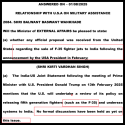That's the thing with reverse engineering. China does it so it's easy right?
Wrong. At the core of it technology is just based off simple rules and equations we learn in primary and secondary school. None of it is hidden or copyrighted
Yet how many people can make use of this blessed knowledge? You have people saying why do we need to learn what calculus is since we will never use it after school?
On the surface reverse engineering seems simple. In reality there's a reason why only a few countries can actually do it.
The simple answer about reverse engineering is that taking apart and understanding a piece of modern equipment like aircraft means absolutely nothing if you don't have the industrial complex behind you to build it. And build it in volume.
The Tejas is a F-5/MiG-21 replacement which India have debilitating issues in producing even with a lot of foreign help and parts. And the foreign parts are not just the engine, radar, avionics and electronic suite but stuff like the nose cone and refueling probe too.
India won't be able to do anything with a F-35 even if you throw in the blueprints and the American designers to help give them the complete understanding of every nut and bolt. They just don't have the industrial and technical base to build most of the parts.

